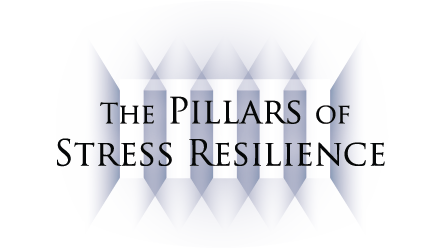
Zvi Strassberg, Ph.D.
Clinical Psychologist
| The Pillars
of Stress Resilience |
Read More | About Dr. Strassberg |
Clientele & Format |
Testimonials | Selected Presentations | Contact |
|---|
- Introducing the Pillars of Stress Resilience
- The Elements of Stress Reactions
- Defining the Five Pillars of Stress Resilience
Introducing the Pillars of Self Resilience
 How do some people rise to meet challenges and rebound from adversity, whereas others struggle when dealing with the same circumstances?
Resilience is the ability to act effectively in the face of challenge or adversity. It is a hallmark of psychological health, and a foundation for success in life's endeavors. In other words, resilience is the antidote to stress.
How do some people rise to meet challenges and rebound from adversity, whereas others struggle when dealing with the same circumstances?
Resilience is the ability to act effectively in the face of challenge or adversity. It is a hallmark of psychological health, and a foundation for success in life's endeavors. In other words, resilience is the antidote to stress.
The fact that Stress Resilience can be developed is particularly good news, because when stress builds or is prolonged it is not only frustrating, but derails clear thinking and productive action, can affect your mental and physical health, and alienates others when directed toward them. Over time, stress can also lead to burnout.
Our work will begin with understanding the elements of stress reactions, and assessment of how your own stress arises and affects you and your functioning.
We will then progress to developing what Dr. Strassbeg calls The Pillars of Stress Resilience, which are capacities identified in current research as central to Stress Resilience. The Pillars of Stress Resilience integrate the positive functioning of mind, brain, and body, and are as follows: maintaining Composure, acting from Meaning, adopting a progress-oriented Mindset, fostering Social Connection, and promoting Physical Well-being. Click “Defining the Five Pillars of Stress Resilience” above to learn more.
The ultimate aims for developing Stress Resilience are to stress less, be more productive, and perhaps most importantly, to live a happier and more fulfilling life.
The Elements of Stress Reactions
People often say that they thrive on stress, that stress is energizing and how they get things done. However, they are not actually describing stress, they are describing a state of positive engagement—where they feel ready, willing, and able to succeed in the challenges they face. Positive engagement is a fundamentally forward-moving experience, in which people “lean in” to challenges.
In contrast, in a stress reaction we suffer from the emotional and behavioral reactivity of a “fight or flight” response. We might experience this state as anxiety, frustration, anger, being overwhelmed, feeling helpless, or another reaction that is full of emotional tension. Our behavioral impulses are to lash out at others or to avoid the situation in some way, neither of which are likely to truly resolve the problem; rather, they are likely to prolong or worsen the dilemmas by causing negative reactions from others that create more stress for ourselves, in a self-perpetuating downward cycle.
All of this means that the times we need to the most capable and full of judgment are the times we are least prepared to do so—and there are consequences that typically just make things worse. Further, the mind/brain/body may also wear down from accumulated stress and implode into the demoralization, cynicism, and emotional fatigue of burnout, so it behooves us to both prevent burnout and foster rejuvenation if burnout does occur.
So... How can we master stress and build positive engagement? The answer is to develop Stress Resilience “from the inside out”—through conscious and strategic improvement in the functioning of our own minds, brains, and behavior. In other words, we can deliberately and intentionally develop capacities for reducing stress reactions and increasing positive engagement. This evolution comes through development of specific Stress Resilience skills and abilities.
Defining The Pillars of Stress Resilience
| Being cool, calm, and collected even in pressure situations. Develop physiological skills for calming your nervous system; and mindfulness skills for activating brain areas involved in self-control, while reducing activity in the areas of the brain triggering emotional reactivity. | |
| Assuring a sense of significance about your professional and personal pursuits. Identifying “touchstone values” will provide foundations for decision-making and action. They ensure a compass for prioritizing, navigating competing demands, managing obstacles, correcting course when necessary, and perseverance. The more you can create alignment between your touchstone values and your decisions and actions, the more you can possess a sense of significance and commitment to what you do, and the better it is for healthy engagement and deeply felt fulfillment. | |
| Adopt a progress-oriented perspective, even (and perhaps especially) in the face of difficulties. Develop capacities for creating, appreciating, and building on the good; and for framing and addressing negative experiences in ways that are productive and build toward your objectives. | |
| No one is an island, and the highest achieving and happiest people recognize the roles that others play in their success and fulfillment. One aspect of social connection is to develop a “success network” of people you trust as confidants, advisors, and for support when the going gets tough; and another is to develop perspective and skills for bringing positive responses from others, both for general benefit and when in difficult circumstances that require joint effort. | |
| How habits of physical self-care improve mood, and support and complement the psychologically healthy habits represented in the other pillars. |
These Pillars can each stand on their own as beneficial, and of course are even more powerful when employed together as antidotes to stress. They are the foundations of Stress Resilience.